A Simple Guide to Skincare (by age)
/in Uncategorized /by Ali Wagstaff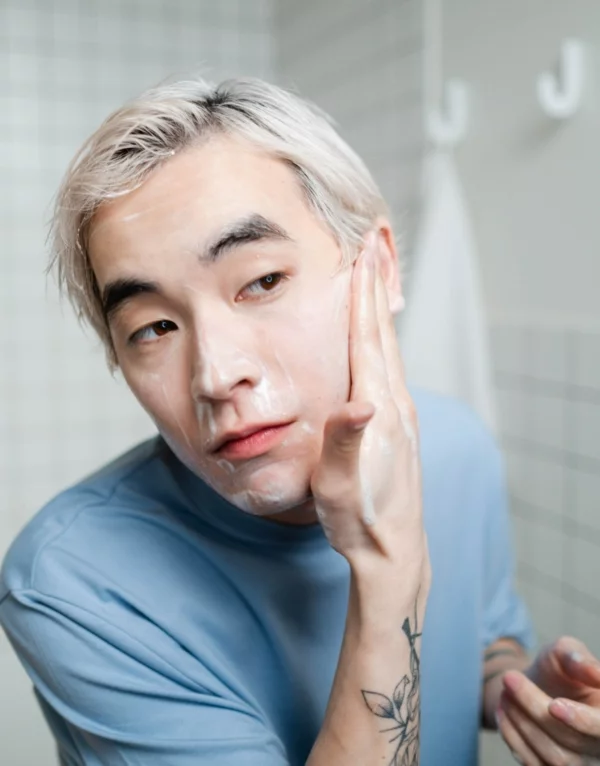
Table of Contents
Ultimate Skincare Products
With how many products are available over the counter AND at your provider’s office, it can be overwhelming trying to decide which skincare products to buy. This is a quick guide on what products and ingredients are most important and we’ve broken it down by age. Now keep in mind that skincare, even by age, is not one size fits all. So it’s still good to have a trusted skincare expert you can go to to get recommendations based on your unique skin. If you’re near Denver, CO click below to book a consult with one of our experts!
A quick note on diagnosing skin conditions
Keep in mind that some skin conditions do really need to be diagnosed and treated by a medical professional. The only providers that can legally diagnose and treat are Physicians, Nurse Practitioners (NPs), and Physician Associates (PAs). Often what looks like acne could actually be a staph infection, a complex dermatitis or even rare types of herpes outbreaks. So if you’re ever unsure, please see a pro. A good aesthetician will also know when to refer to a medical provider. As usual, nothing in this article is meant as medical advice or to diagnose and treat. We can’t do that without seeing you in person so talk to your prescribing provider before trying anything new :-).
Basic Skincare Routine For Teen's
- For teens, it’s recommended to use a gentle, non-medicated cleanser most days, with an option to incorporate a salicylic acid based cleanser a few times a week to prevent acne. The salicylic acid could be increased to daily use for moderate acne (more on acne in next section).
- DO NOT use a toner or exfoliating pads (or at the very least use extreme caution). Many toners and pads, especially those tailored towards teens and acne-prone skin, are loaded with drying alcohols (SD alcohol, alcohol denat.) that strip the skin of oil, which may seem good in the short term, but this can lead to increased oil production, damage to the skin’s microbiome, and worsening acne. Consider witch hazel as an alternative to harsh toners.
- Moisturizing is important, even for oily skin. They make moisturizers for all skin types for a reason, so just because someone has oily skin doesn’t mean their skin doesn’t need hydration—in fact it can help balance oil production and keep the skin from feeling and looking tight and shiny.
- Always wear sunscreen every day. Usually hybrid organic/inorganic (“chemical” and mineral) filters are best for oilier skin types (ie. octinoxate and zinc oxide) because they tend to be less oily. Sunscreen not only protects from the sun but can prevent scarring from acne and is also anti-aging.
- Keep the routine simple, and if you’re struggling, consider seeing an aesthetician for an initial evaluation or going straight to a dermatologist for more complex skin issues.
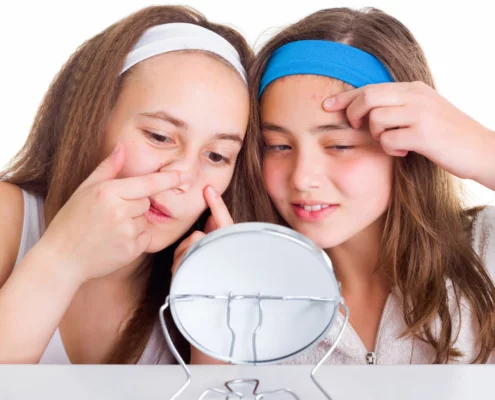
Teen skincare regime step-by-step
- Cleanse nightly with a gentle cleanser
- Optional salicylic cleanser for acne prone skin
- Avoid alcohol based toners and exfoliating pads
- Moisturize and use sunscreen daily
- See an aesthetician or get referral to dermatology for complex issues
Best Skincare for Acne Prone Skin
- The best acne skincare routine depends on the type of acne like shown in the image above.
- Superficial and mild acne typically responds well to salicylic acid cleansers and light hydration. Salicylic acids can penetrate deep into the pores to break up oil and kill bacteria.
- For moderate acne, a combination of a benzoyl peroxide face wash a few days a week to kill bacteria (and a gentle cleanser other days) and a topical retinoid serum/cream like retinol, retinaldehyde or adapalene gel can help unclog pores and speed up cell turnover. Remember to never use benzoyl peroxide with hydroquinone (a skin “lightening” agent) as dark staining of the skin may occur.
- For severe and hormonal acne, seek out help from a specialist like a dermatologist, who may work with an esthetician as well to come up with a series of specific treatments such as chemical peels or laser, and at home care.
- Also consider working with a nutritionist to determine if you have an imbalance in your gut or food sensitivities that could be contributing to acne.
- In general, monthly chemical peels in a series of 3-6 are a great option for those suffering from mild to moderate acne.
- Avoid products containing high amounts of drying alcohol.
- Always wear sunscreen and keep skin hydrated to prevent scarring.
- Blue LED light or IPL can also be very beneficial for acne.
Acne Prone Skin Summary:
- Mild acne salicylic acid cleansers or pads
- Moderate acne add in benzoyl peroxide and retinoid products
- Severe acne or hormonal acne seek help from dermatologist or skincare expert
- Consider working with a nutritionist to see if a gut imbalance or food intolerance is contributing
- Do regular facials and peels
- Always wear sunscreen
- Blue light therapy may be helpful
What is the best skincare routine in your 20’s?
- This is a great age to start coming in for regular monthly facials. Regular facials are very helpful to have your skin looked at monthly and they can also speed up cell turnover.
- Weekly exfoliating cleansers or leave on exfoliants such as salicylic acid or glycolic acid can be started or continued.
- Consider introducing a topical vitamin c serum. Vitamin C is an anti-oxidant that helps protect your skin from damage. It also acts a light exfoliant. Look for ascorbic acid, ascorbyl glucoside and/or tetrahexyldecyl ascorbate.
- Consider changing to a more hydrating moisturizer as skin typically changes from puberty, and ends up producing less oil. Look for ceramides and fatty alcohols.
- Consider starting a retinoid. Look for retinol or retinal/retinaldehyde as they tend to be more gentle. Start slowly and always reduce use if there is irritation.
- Continue to wear sunscreen daily.
- In the mid to late 20’s consider starting preventative Botox.
- Microneedling can also be great for those with acne scars or those that want to do something to prevent lines and wrinkles.
Skincare in 20's Summary:
- Start monthly facials and peels
- Use at home exfoliants
- Start retinoids
- Always wear sunscreen
- Consider preventative Botox and microneedling
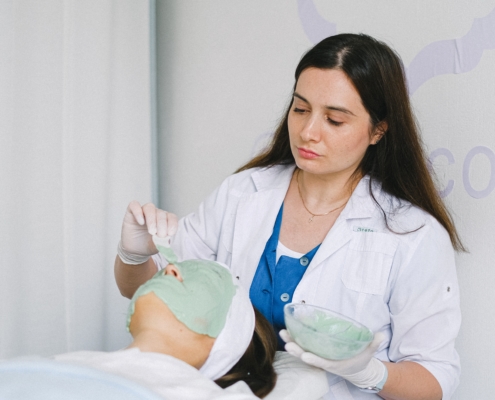
What is the best skincare routine in your 30’s?
- Consider switching to glycolic or lactic based exfoliants instead of salicylic acid for non-acne prone skin.
- Start to consider quarterly Botox and even yearly preventative fillers. We all lose about 1 syringe of filler per side of volume after age 25-30.
- Consider microneedling and IPL to help tighten skin, rebuild collagen, address any scarring or hyperpigmentation caused from past acne or sun exposure.
- See an esthetician for monthly facials/peels.
- Continue using a retinol in the evening (or every other evening) and vitamin c in the morning (if able to tolerate both), and wear sunscreen daily. Don’t forget to reapply sunscreen every 1.5-2 hours when in direct sunlight! There are great powder SPF sunscreens available that can be used over make-up
Skincare in 30's Summary:
- Use lactic acid or glycolic acid exfoliates if having less break-outs
- Consider quarterly Botox and yearly preventative fillers
- Consider microneedling and IPL
- Monthly facials and peels
- Continue retinoids, vitamin C and sunscreen
What is the best skincare routine in your 40’s?
- Skin is usually dryer, so using a lactic acid or enzyme-based exfoliant can be helpful.
- Consider deeper, more nourishing creams that contain things like ceramides, plant sterols, and amino acids/peptides. This product is a great option.
- Quarterly Botox, yearly fillers and IPL are usually more essential now to make up for volume loss and to smooth out expression lines.
- See an esthetician for monthly facials/peels.
- Continue using retinol and vitamin c serums, and of course wearing sunscreen every single day.
- See a dermatologist for annual skin cancer checkups if you haven’t already (can start at any age, the sooner the better).
- Consider resurfacing lasers for deeper lines and wrinkles.
Skincare in 40's Summary:
- Use lactic acid or enzyme based exfoliants.
- Use nourishing creams that contain ceramides, plant sterols and amino acids/peptides.
- Quarterly Botox, yearly fillers and IPL are more essential now.
- Continue monthly facials and peels.
- See a dermatologist yearly for skin checks.
- Continue retinoids, vitamin C and sunscreen.
- Consider resurfacing lasers.
What is the best skincare routine in your 50’s and 60's?
- Use enzyme and lactic based exfoliants as they are gentler and less drying on mature skin.
- Use hydrating, cream-based cleansers that can nourish the skin and keep it more hydrated.
- Use thick cream moisturizers with fatty alcohols, oils, plant sterols, and amino acids/peptides. Maybe even consider adding a facial oil to the evening routine for extra moisture.
- Quarterly Botox, yearly fillers and IPL treatments are essential. You may even want to consider laser.
- See an esthetician for monthly facials/peels.
- Continue using retinol and vitamin c serums, and wearing sunscreen daily.
- See the dermatologist for annual skin cancer checkups.
Skincare in 50's and 60's Summary:
- Use lactic acid or enzyme based exfoliants
- Use nourishing creams that contain ceramides, plant sterols and amino acids/peptides
- Quarterly Botox, yearly fillers and IPL are essential
- Continue monthly facials and peels
- See a dermatologist yearly for skin checks
- Continue retinoids, vitamin C and sunscreen
- Consider resurfacing lasers
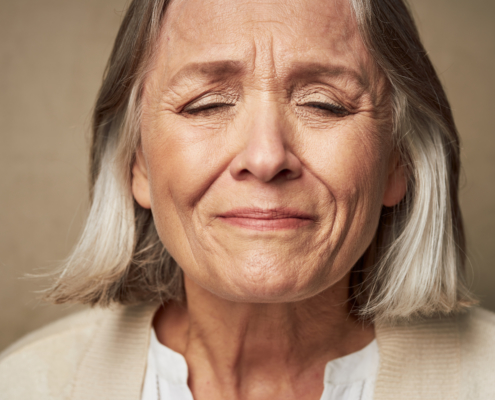
Were do I start with skincare?
If you’re reading this and you’re feeling way behind because you haven’t started anything, that’s ok! It’s never too late to start good skincare. At any age here are the absolute essentials with each additional add on:
What are skincare essentials?
- Wash your face every night with a gentle cleanser. It’s important to wash off make-up, dirt, oil, grease and whatever else from the day, every day.
- Wear sunscreen EVERYDAY! No, your tinted moisturizer or makeup does not count! Wear a broad spectrum SPF 30+ every day under your make-up. Then re-apply every 2 hours if by a window, driving, or in direct sunlight. You can use a sunscreen powder over make-up to make this easier.
- Consider adding in a retinoid. Retinoids help speed up turnover of skin cells which in turn, reduces fine lines and wrinkles, decreases discoloration and they can actually reverse DNA damage from the sun.
- Consider adding in a Vitamin C serum, if you can tolerate this with a retinol. If you can’t, prioritize the retinoids.
- Consider Botox or Xeomin, Fillers, and IPL/Lasers. We never think we need services, until we start to age and see the years catching up with lines, wrinkles, lost volume and discoloration. Maintenance treatments are key when aging gracefully and naturally.
- Consider monthly facials and peels for regular skin assessments. Consider getting a VI Peel that is more advanced, a few times a year, too.
What is medical grade skincare?
Medical grade skincare requires more rigorous testing and has to be proven to be 99% pure. Cosmetic grade, or what you can get over the counter, only has to be 70% pure. So many over the counter products are great but if you have any skin conditions or want to be able to guarantee the quality of your products you want medical grade.
When it comes to skincare products, do your research or talk to your skincare expert to decide what is best for you.
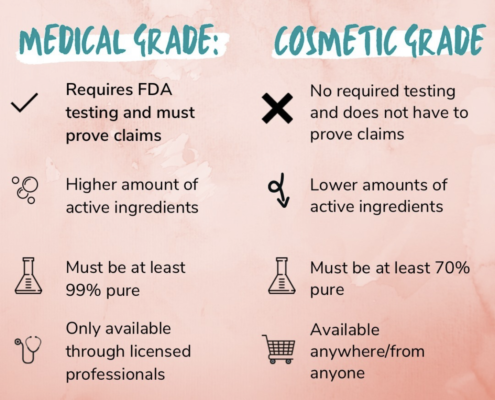
What should I avoid to prevent aging?
In conjunction with the information above, here are 2 things that you must avoid to prevent aging!
- Avoid tanning beds unless it’s just for the red light therapy. You may look good tan in your 20’s and 30’s but as you age you will look older and older because of damage from tanning beds. Consider a spray tan, instead. Many people will say things like, “well fat looks better tan”, but tanning damages skin making it thinner- this causes more cellulite to show and skin to appear thin and wrinkly.
- Quit smoking tobacco. This is tough because it’s a very hard habit to break. However, if you are prioritizing anti-aging, you have to quit smoking! Smoking is the next biggest contributor to premature aging, after sunlight.
Need help with your skincare routine?
Book a consult below with one of our NP providers to talk about skincare, customized treatments, and any other questions you may have!

